New use cases for AI pop up every day, each promising a utopia of ultra-efficiency and endless brilliant ideas.
But do they really work for small businesses, where there’s little time to develop complex solutions or wait for future returns?
To find out, I ran five experiments to see if AI workflows and prompts that marketers and business leaders are already using could be adapted for local businesses (think: plumbers, yoga studios, or private preschools).
In this guide, you’ll see what worked, what didn’t, and how you can use each tactic for your own business right now.
Contents
1. Use online forums like a giant focus group
Online forums are an absolute embarrassment of riches when it comes to learning about your customers. Reddit, Quora, and other niche messaging boards hold millions of unfiltered ideas and opinions you can use to guide content marketing, product development, positioning statements, and so much more.
Here’s the rub: there are SO many conversations happening that it’s nearly impossible for a human to sift through them all.
Abby Mood, the marketing director at Velocity Advisory Group, uses ChatGPT to scour these digital spaces for common questions her target audience is asking.
The experiment
For this experiment, I took on the role of a content marketer for a physical therapist and running coach. My goal was to get a list of questions my target audience of runners asks about nutrition so that I can turn them into a series of blog and social media posts.
Abby gave me the editable prompt she uses for the task:
“What are the questions [target demographic] are asking the most frequently about [topic/service/pain point]? Look for them on social sites, forums, Reddit, Quora, and other places where [target demographic] ask questions. Find as many as possible. Then, categorize them and rank-stack them by frequency.”
I swapped in the demographic as “runners” and the topic as “nutrition.”
ChatGPT identified five topical categories, ranked them by frequency, and added some representative questions from these threads.
This summary is great. But I also wanted the raw data organized in a table. Abby has a prompt for that, too:
“Format the report with a table at the top summarizing your findings. Then, make each category a heading to be followed by a quick summary of what you found for that category and about a dozen bullets of direct quotes you found that represent that category.”
It created a table with 121 representative questions runners are asking about nutrition. They’re ranked by frequency and categorized by topic. The AI let me download the table into a CSV, and I did a little formatting to make it easier to read.
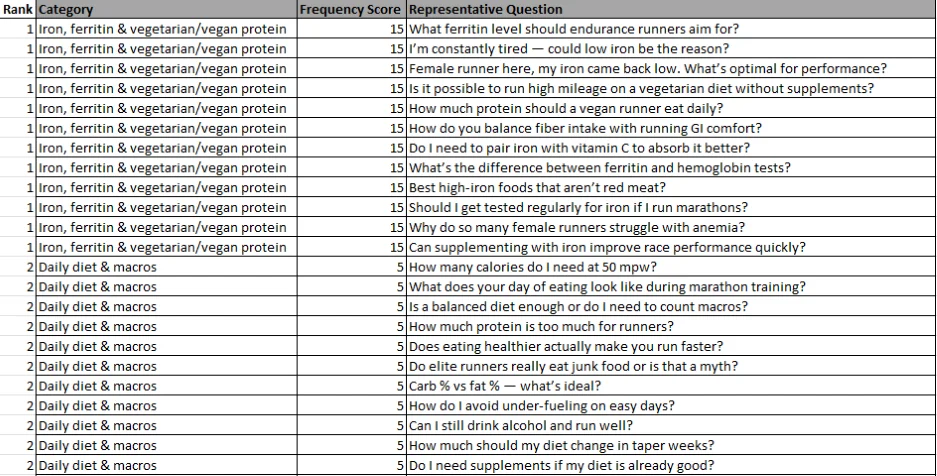
This is a fantastic list of questions I can bake into blog posts, guides, TikToks…whatever! The process took me less than five minutes to complete.
How to use this tactic
It’s easy enough to simply change the topic and audience in Abby’s prompts. From there, I’d do a few more things to help fill my content calendar:
- Use Google and Ahrefs, Moz, or our Free Keyword Tool to see if any of these terms have close SEO keyword equivalents.
- Look for the questions that aren’t answered to death by my content competitors.
- Look for obvious groupings of questions that can be expanded into a more comprehensive piece of content.
But the potential goes far beyond content. I could see a nutrition business using this to either develop supplements or a dietary program that addresses these questions. Alternatively, an advertiser could build a campaign around how their products address these concerns.
🤖 Want more? Download the Emergency Guide to AI in Marketing
2. Repurpose content into social media posts in a flash
No other marketing channel lets local businesses connect with so many people in such an engaging way as social media does. But a plumber or local dentist won’t typically have a full-time, dedicated social media marketer who can create posts fast enough to fill the never-ending need for content.
Anna Burgess Yang knows this challenge well. She’s a content marketer and a solopreneur who has to squeeze in time to do social while keeping a busy client schedule (plus billing and all the other tasks of a small business).
Luckily, Anna is also an AI tool tinkerer. She recently shared with us how she transforms interview transcripts and other lengthy assets into social media posts in just a few seconds. “I’ve already done the hard work by crafting long-form content. Why not use AI to speed up the process of creating social posts?” she explained.
The experiment
Anna uses a paid version of Writer for this job. I’m using trusty ol’ ChatGPT. My goal is to turn a blog post, this time from a local lawn care business, into publishable social media content quickly.
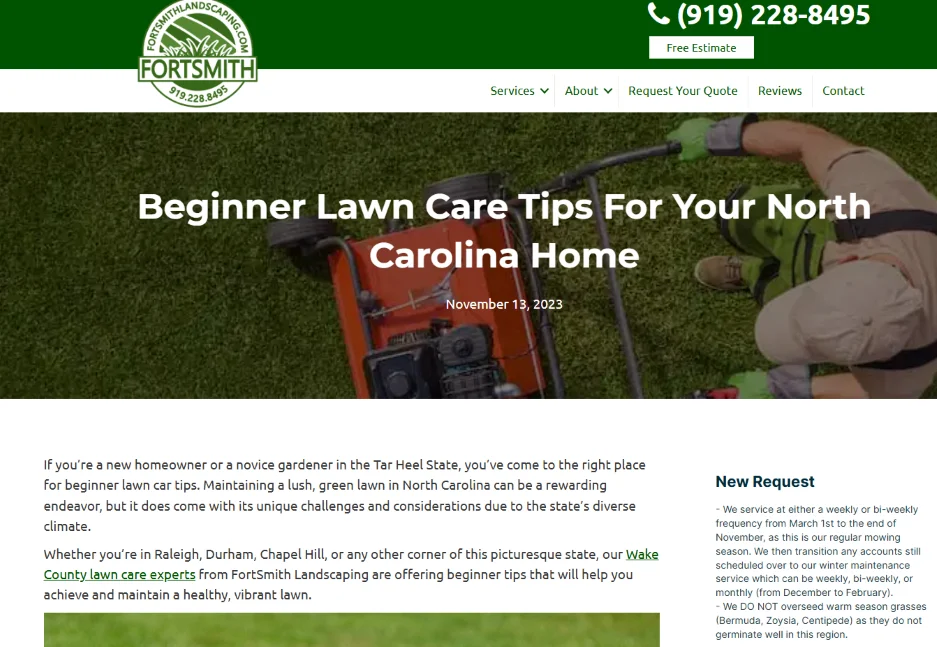
Source
Anna likes the prompt, “Summarize this post into three key takeaways.” I’ll start there. Here’s what ChatGPT gave me:
Here’s where Anna would move these three points into her task management tool and use them as the basis for future social media posts.
For my experiment, I’m going right to the social post writing stage. I’m not a fan of using AI to write copy wholesale. But I wanted to give it a try for this experiment.
Here’s the prompt I entered and one of the posts it wrote:
“Can you turn these three topics into three social media posts? Focus on a style that’s good for Facebook, but make them useful for Instagram and X/Twitter, too.”
Here’s one of the posts.
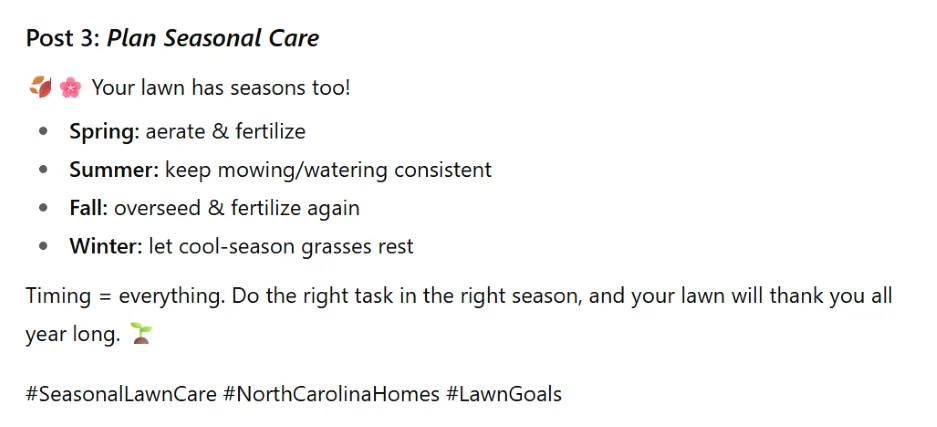
It’s definitely not a style of post I’d publish. And the overuse of emojis is a common AI tell. But I do like that ChatGPT added some hashtags. It definitely needs a call to action. And to be fair, the blog post was pretty high-level.
I decided to try one more. This is a much longer post about running nutrition. I skipped the “key takeaways” step and just asked for three social media posts.
I ran into a problem.
It gave me three different ideas for the same blog post. What I wanted was a series of three posts I could plan out for the next week. So I modified the prompt to:
“Read this blog post. Pull out three key points that would make good social media posts. Then write the three posts, making sure they don’t cover the same points. Keep them concise.”
It produced three posts around unique topics:
- Fueling before and during your trail run
- Recovery and common nutrition mistakes
- Smarter everyday nutrition for trail runners
Here’s an example of the output:
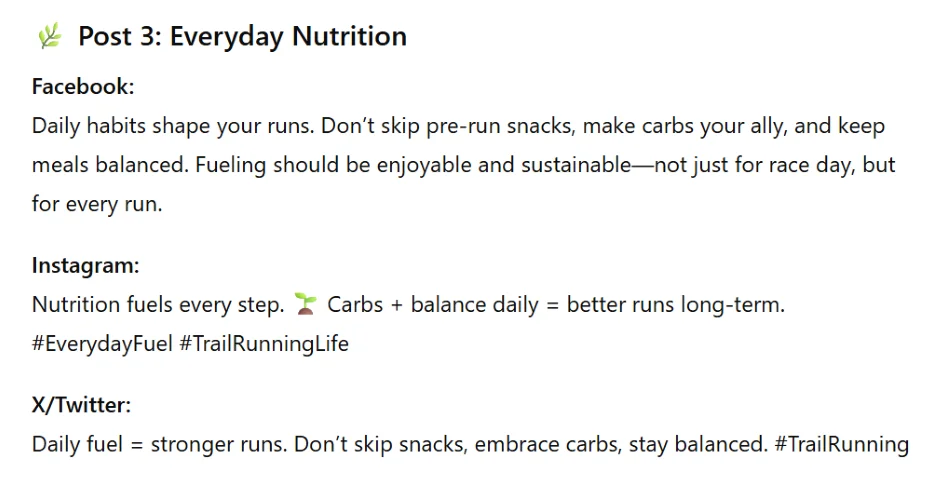
Still not fantastic. But it’s at least a start.
How to use this tactic
After running this experiment, I think I’d use Anna’s initial method and just get ChatGPT to pull key concepts from a long bit of text.
For a local business, that could be a blog post or ebook. It could also be from the transcript of a talk they gave at a local event. Or it could even come from recorded customer conversations and sales pitches.
3. Create comprehensive SEO outlines quickly
The most effective blog posts are built on well-crafted outlines. When you have a solid structure, a novel theme, and strong key components (like stats and quotes), the end result has a much better chance of engaging readers and being ranked by search engines.
Now, it’s not new to ask AI to throw together a quick outline. But Chris Long, co-founder of Nectiv (an SEO and GEO services provider), detailed a workflow he uses to get a way more comprehensive version that’s dialed in for SEO.
The experiment
Chris uses ChatGPT in Agent Mode, along with a detailed prompt, to review currently ranking content, analyze informational gaps, and source questions that need to be answered based on a keyword.
In case you’re new to it, Agent Mode combines ChatGPT’s Deep Research capabilities with its Operational functions. That means you can give it complex, multi-step tasks that require digging through multiple websites.
I took on the persona of marketing manager for a private preschool. The test aims to determine if I can obtain a usable SEO-focused outline from ChatGPT’s Agent Mode for a relevant, high-volume keyword.
I decided to base this test on the keyword “preschool curriculum” because it has decent search volume and a manageable difficulty level.
I used the exact prompt Chris shared, only adjusting it for my keyword:
“Can you look at the top Google results for ‘preschool curriculum?’ Based on those results, can you provide a content outline that contains: 1) 6-8 sections of content to create with notes, 2) FAQs to add to the page, and 3) Semantic entities to include on the page.”
Agent Mode went to work. Over the course of 8 minutes, it read several ranking articles and seemed to search for subtopics (like match curricula, etc.). It also stated that it was verifying citations.

As Chris suggested, ChatGPT created a pretty detailed outline. Each subsection had three to five bullet points with citations. This is the final subsection:
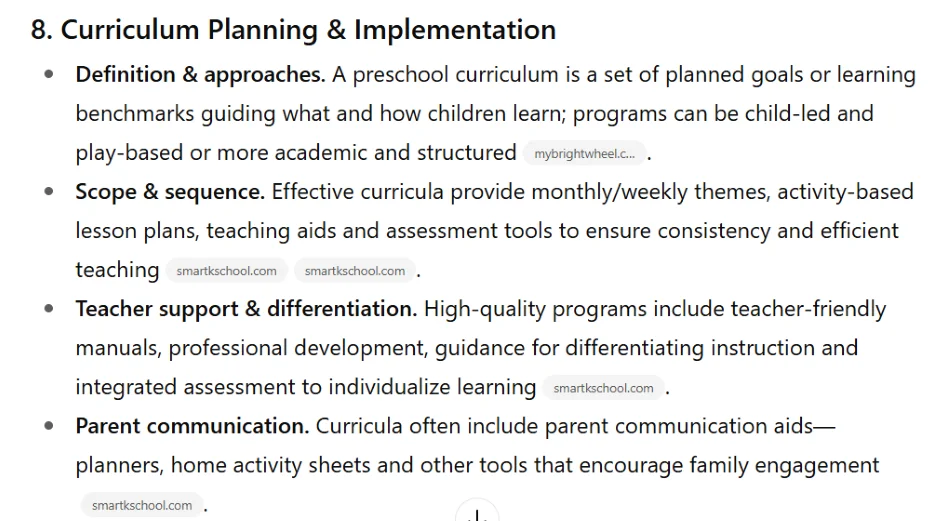
There was also a list of five FAQs and a big list of semantic entities to include.
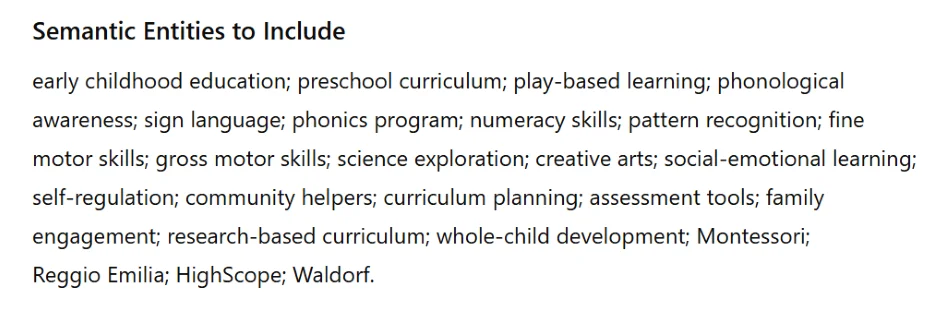
I found the subtopics and semantic entities to be helpful. But I noticed some obvious sections missing for this to meet the reader’s intent. I think that’s down to two things:
- ChatGPT chose an intent: The intent of the highest-ranking posts was mixed. Some were promotional and aimed at educating parents about a school’s curriculum. Others were informational and written for an audience of teachers and administrators. ChatGPT chose a fairly generic intent designed for parents.
- It didn’t address Google search features: The outline doesn’t seem to follow or reference the topics in Google’s “People also ask” or “Things to know” snippets.
How to use this tactic
Chris’s strategy would be really useful to help a non-SEO expert create blog post outlines. You could even use this for your newsletter or lead magnet guides.
Chris said in his post that this is a progressive work that can take some back and forth to get it where you want it. Here are some things I’d do to dial in the results:
- Confirm your target audience: Don’t make the AI decide who your audience is. Add that into your prompt so if the intent is a little murky, you’ll get an outline that’s relevant to the people you need to engage.
- Feed it SERP info: Agent Mode told me it can’t access live SERP features like People also ask. Those are important to address in an SEO blog post. So try copying and pasting them into your AI dialogue.
- Switch to standard mode for basic questions: Agent mode does a lot of deep thinking. If you just want to know something like “can you access SERP features,” it’s much faster to switch to the standard ChatGPT mode and ask it.
💡 SEO is a good option for driving traffic. Find more in 25 Ways to Increase Traffic to Your Website
4. Pull insights from hundreds of customer reviews
We write a lot about the importance of online reviews for small businesses. In my opinion, they’re one of those marketing assets that are truly critical for growth but also really difficult to wrangle (especially if you get a lot of them).
My next experiment is based on an idea posted by Matt Meazy, a freelance SEO consultant, on LinkedIn. The idea is to get AI to review hundreds of online reviews for your business, then pull and organize valuable insights.
The experiment
I wanted to start off on a good foot, so I reached out to Matt for more details. He said he uses Agent Mode in ChatGPT for this one. Here’s the prompt Matt feeds it:
“Visit these two websites, analyze all reviews, and create a document here that summarizes the findings. I want to know commonalities and patterns, both positive and negative, for each of the venues and each product. I will use this insight to create content on the website, such as “guest says”.
I went a little broader with it and asked Agent Mode to find all reviews on Google, Yelp, or any other review sites for Rite Plumbing, an actual plumber based in New York. It spent 26 minutes on the task.
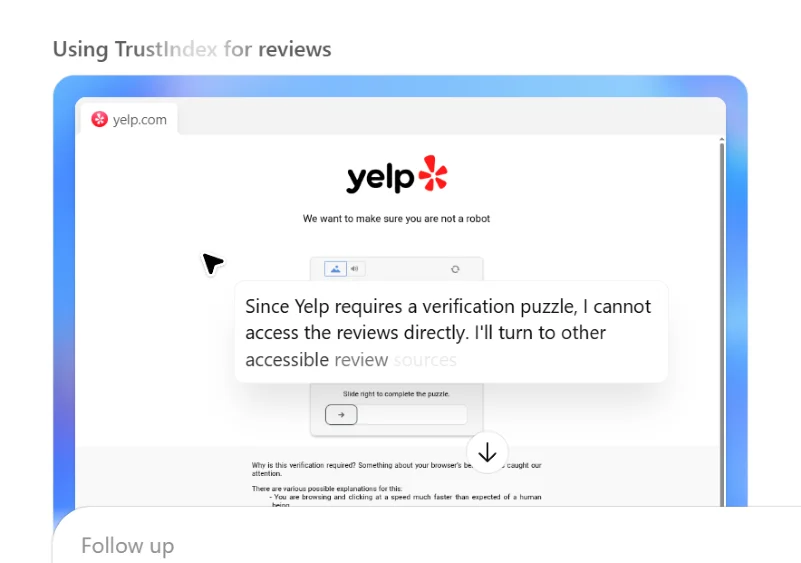
Holy cow, did this one deliver! ChatGPT spun up a full report on what it learned from dozens of websites and possibly hundreds of reviews (it was hard to say how many in total).
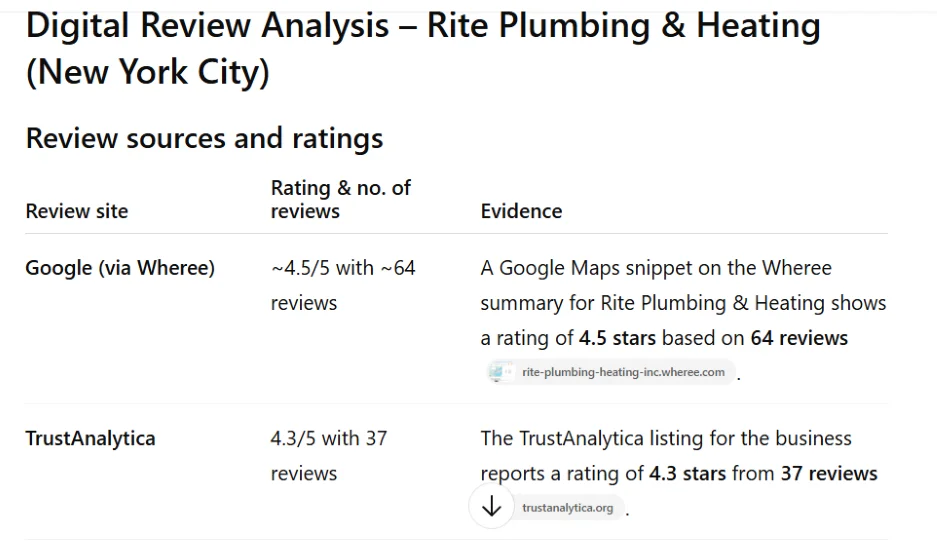
The report listed commonly perceived strengths of the business (responsiveness, good communication) as well as weaknesses (higher prices). It also elaborated on some of its findings for each review site.

One thing I noticed was that my report didn’t show specific customer quotes. That’s because it couldn’t read the actual reviews from Google. It had to rely on third-party websites that mentioned those reviews.
How to use this tactic
There are several places I could use this information for my plumbing business. I could spot directories where my rating is low and see if it’s getting review bombed. I could share the ratings on my website and social posts. I could also use the feedback to change up my services or reposition them to better meet expectations.
Matt uses actual customer quotes as social proof in marketing assets, which is absolute gold. I think the next experiment would be to try giving ChatGPT a specific directory to see what it can read, and rework the prompt to ask for quotes.
5. Analyze your competitors
Studying your competitors can be the best source of new ideas to grow your business. It’ll highlight gaps in your product or service offerings, give you new ways to position what you sell, show you which customer segments aren’t being serviced, and a whole lot more.
Celia Quillian, director of AI and growth at Greenlight, told us how she makes that easier by using ChatGPT to analyze competitors’ websites for things like branding, product descriptions, and so on.
The experiment
I tried a version of this using the unpaid version of ChatGPT a while ago with limited results. For this experiment, I wanted to see if the updated, paid version could do better. And if it would work for a small local business. In this case, a yoga studio.
I started by asking ChatGPT to provide a comprehensive and reusable prompt. Here it is:
“Review these three competitor websites: [link 1], [link 2], [link 3].
Analyze them for:
- Pricing – How they show or hide prices, tiers, packages, or promotions.
- Branding & Messaging – The tone, visuals, and value propositions they use to appeal to customers.
- Positioning & Differentiation – What makes each stand out (or blend in) compared to the others.
- Website Experience – Ease of navigation, calls-to-action, and how clear it is for a visitor to take the next step.
- Content & Engagement – Use of blogs, FAQs, videos, reviews, or other elements that build trust and engagement.*
Finally, summarize the strengths, weaknesses, and opportunities for a small business competing with them.”
I switched back to Agent Mode and put AI to work reviewing the websites of three top-rated yoga studios in Los Angeles.
Using just this prompt, ChatGPT created an eight-column table with information for each of the three businesses. It was a little hard to read in the dialogue box, so I asked for a downloadable CSV file.
Again, a touch of formatting and, voilà:

I think the best part is the cost analysis. If you pick the three studios nearest yours, you could quickly see if you’re over- or under-priced for your neighborhood. Plus, you’d get ideas for how to create and promote packages.
I also loved the weaknesses column. It shows several ways you could gain an advantage, like with pricing transparency and a more easily navigable website.
How to use this tactic
As is, Celia’s tactic is instantly usable for just about any local business. My experiment is also just the beginning of what you can learn.
For example, I asked a few of these questions and got back a lot more detail:
- Do these websites have a blog, and have they published recently?
- How does the website capture leads or motivate visitors to take the next step? Do they use specific calls to action? Is their schedule system easy to find?
- What types of social proof do they include (reviews, testimonials, awards, etc.)?
- What do they do for local SEO (do they mention the city or neighborhood name often, show involvement in community events, partner with local businesses)?
You may have clued in on the mentions of “reviews.” You can combine this tactic with a review search to see what people say about your competitors and gather additional information to work with.
Try these AI tactics for your business
The goal of these experiments was to find ways a small business can use AI for better marketing. The overall answer is yes, each of these tactics can be adapted for a local business to use quickly.
Each business is unique, though. And AI has seemingly infinite adaptability. So try the prompts and workflows I’ve listed here, and then start asking your AI more questions about the results. If you want to know more about your competitors or which products people have the most problems with, challenge AI to figure it out.











